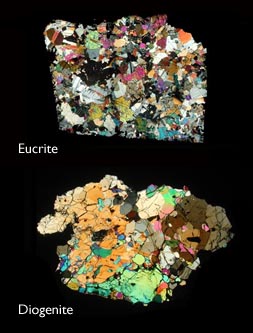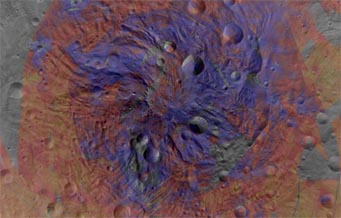NASA's Dawn spacecraft has confirmed that the composition of asteroid 4 Vesta matches that of hundreds of meteorites already in the hands of planetary scientists.

Slices of eucrite and diogenite meteorites, viewed through a polarizing microscope, show different minerals in different colors. The texture of the rocks reveals that crystallized from magma at different rates.
Univ. of Tennessee
For decades, planetary scientists have suspected that the second-largest asteroid, 4 Vesta, is the source of hundreds of meteorites collected here and there on Earth. These rocks, termed howardites, eucrites, and diogenites (HEDs), are igneous — they solidified from a molten mass, either quickly as a surface lava or more slowly in insulated reservoirs deeper down. Even seen from afar, Vesta likewise has a spectrum consistent with fire-formed rocks.
But Vesta lies deep in the asteroid belt, averaging 2.4 astronomical units (350 million miles) from the Sun. So how, exactly, could these chunks migrate to Earth from so far away? The "case for Vesta" has taken decades to prove. Detailed views from the Hubble Space Telescope show a huge impact crater near its south pole (Ejection mechanism? Check!) During the 1990s, Richard Binzel (MIT) led the charge that discovered a family of smaller asteroids with spectra identical to Vesta. These shards were located near gravitational resonances with Jupiter that provide dynamical "escape hatches" that would fling them inward on paths that cross Earth's orbit (Delivery mechanism? Check!)

This map shows the distribution of pyroxene, an iron- and magnesium-rich mineral, in the southern hemisphere of Vesta. Purple regions have a higher proportion of pyroxene, indicating excavation of the crust by impacts that have revealed deeper layers.
NASA / JPL / UCLA / INAF
Now NASA's Dawn spacecraft has made the case airtight. After months of orbiting Vesta, Dawn's visual and infrared spectrometer has mapped Vesta with enough detail to reveal unambiguous spectral fingerprints. Crustal rocks in its northern hemisphere match the composition of eucrite and howardite meteorites, and the samples in and around the giant Rheasilvia basin at Vesta's south pole (presumably dredged from deeper down) are a match to diogenites. "Dawn's observations have convinced most of us — certainly me — that Vesta is the HED parent body," admits Hap McSween (University of Tennessee, Knoxville).
It's all coming together very nicely. For example, crater-counting by Dawn investigators show that Vesta's northern hemisphere is ancient, probably dating to the time of this body's formation 4½ billion years ago. Yet down south, near Rheasilvia and a second, older basin beneath it named Veneneia, small pits are sparser, suggesting that Rheasilvia was gouged out only about 1 billion years ago. That's still ancient, for sure, but it's unexpectedly young given the shooting gallery that must have existed in asteroid belt eons ago.
Moreover, careful tracking of Dawn's motion while in orbit suggests that Vesta is center-weighted, with a metal-rich core about 140 miles (225 km) across — roughly 40% of this object's 330-mile (529-km) mean diameter. "Dawn demonstrates that Vesta is a small differentiated planet," comments Cristina De Sanctis, a VIR investigator from the Italian National Institute of Astrophysics.
All of these Dawn results, and plenty more, appear in this week's issue of Science. You can read NASA's announcement or check out the briefing video on YouTube.
 6
6
Comments
Richard Carroll
May 12, 2012 at 9:18 am
Great article. But you call Cristina De Sanctis a "VIR investigator". What? Also she calls Vesta a "...planet". Here we go again!
You must be logged in to post a comment.
Rod
May 12, 2012 at 1:41 pm
The NASA link provided in this report indicates two large impacts on Vesta are now dated at 2E+9 years old and 1E+9 years old. The HED meteorite population typically has very young cosmic ray exposure ages, perhaps a mean around 20E+6 years old or so. I find age calculation differences like this intriguing when it comes to explaining why the numbers differ so much.
You must be logged in to post a comment.
Charles Peterson
May 16, 2012 at 4:23 pm
"Gravitational resonances with Jupiter" are not, by themselves, sufficient to serve as an efficient (or even as a feasible) "Delivery mechanism". This is because an asteroid's orbital elements, especially the major axis, must fall in a very narrow range for such resonances to be effective. However, the Yarkovsky Effect produces a small but constant tangential component of force on a rotating asteroid that is capable, by itself, of reducing the major axis of a one meter rocky body from 3 AU to 1 AU in 30 million years. This time scale is consistent with the cosmic exposure ages of rocky meteorites. But the major importance of the Yarkovsky Effect is that it alters the orbital elements of ALL small (<10 km) asteroids to make them resonant, even if they were not originally ejected into (or even near) such orbits. Because it operates as a light-pressure type force, the Yarkovsky Effect leaves the larger asteroids comparatively unaffected.
You must be logged in to post a comment.
Bruce
May 16, 2012 at 10:50 pm
Charles, interesting comment. When a small asteroid is moved into one of these resonant orbits by radiational forces such as the Yarkovksy effect would it then be trapped there? It would seem that it would be, and thus these solar effects together with Jupiter's great mass serve to reduce the rate of asteroidal impact here on Earth.
You must be logged in to post a comment.
Charles Peterson
May 17, 2012 at 2:52 am
There are at least two main categories of orbital resonance that I am familiar with including commensurability resonances (such as Neptune-Pluto 3:2 and Titan-Hyperion 4:3) and secular resonances (such as the "nu6" with Saturn). Although I have not studied these phenomena myself, I believe that radiation forces, such as Yakovsky and Poynting-Robertson, both cause the orbital major axis to change slowly and continuously in such a way as to "pass through" the resonant conditions. However slowly the major axis is forced to change by non-gravitational forces, it is the orbital eccentricity that undergoes extremely rapid changes near resonance, which in and of itself leaves the major axis untouched, at least in the case of the "nu6" secular resonance (near a=2.06 AU). So I believe that these radiation forces will only lead to temporary trapping until these same continuous forces push any captured asteroids back into free orbits again.
You must be logged in to post a comment.
Charles Peterson
May 17, 2012 at 3:25 am
Continuing (under the 2000 character limit), Jupiter's (and Saturn's) great gravitational influence can still greatly reduce Earth-asteroid impacts via resonances, without trapping, as follows. First, radiation forces "feed" a resonance by slowly changing the orbital major axis. Second, the resonance acts to rapidly increase the orbital eccentricity and so make a close gravitational encounter with a major planet inevitable. Third, the asteroid either collides with a planet, is expelled from the solar system, or is placed into an orbit that makes future planetary encounters even more likely. Depending upon the sense of the asteroid's spin, the Yarkovsky Effect can increase as well as decrease the object's orbital major axis. Those asteroids that happen to enter orbits of increasing size and eccentricity (about one half) will most likely suffer a close Jupiter encounter which prevents them from ever approaching Earth. Thus Jupiter's great mass AND LOCATION do, in fact, serve to protect the Earth from many, but not all, asteroids collisions.
P.S. In my first post please replace "cosmic exposure ages" with "cosmic ray exposure ages".
You must be logged in to post a comment.
You must be logged in to post a comment.